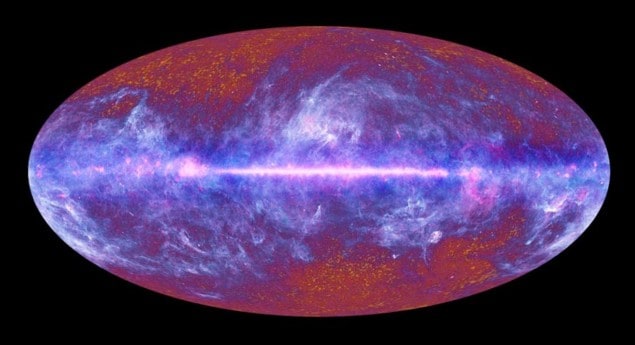
ESA’s Planck mission has released its first full-sky map. The image shows the cosmic microwave background (CMB) in higher resolution than ever before and it may help cosmologists to develop a much clearer picture of the early universe.
“This is the moment that Planck was conceived for,” says David Southwood, who is ESA’s director of science and robotic exploration. “We are opening the door to an Eldorado where scientists can seek the nuggets that will lead to deeper understanding of how our universe came to be and how it works now.”
The Planck mission was launched in May 2009 with the main goal of mapping the CMB, the primordial radiation leftover from the Big Bang. Slight variations in the temperature of the CMB are believed to reflect fluctuations in the early universe from which large structures such as galaxies would later evolve.
The CMB was initially detected in the 1960s and its study in the 1990s using NASA’s Cosmic Background Explorer (COBE) satellite won George Smoot and John Mather the 2006 Nobel Prize in Physics.
Ancient polarizations
In 2003 the first full-sky survey of the CMB was produced by NASA’s Wilkinson Microwave Anisotropy Probe (WMAP). In addition to temperature, WMAP also measures the degree of polarization of the ancient microwave photons – providing more information about the early universe.
The Planck mission is expected to surpass WMAP by detecting a so-far unobserved type of polarization known as “B-modes”, which are believed to date back to the period of inflation and are determined by the density of primordial gravitational waves.
The image released today is generated from six months’ worth of data, and ESA is expected to release the first scientific analysis of the image within two years.
This first image is proof that the instruments are working perfectly Nazzareno Mandolesi, INAF
“This first image is proof that the instruments are working perfectly,” said Nazzareno Mandolesi of the Italian National Institute of Astrophysics (INAF), speaking this morning at the Euroscience Open Forum in Turin, Italy. “We can say that just 15 days of Planck are much better than five years of WMAP,” he added.
One of the main scientific goals of the Planck mission is to investigate what happened during the inflationary period shortly after the Big Bang, when the universe expanded by 1028 within just 10–36 of a second. This process is necessary in all mainstream models of the universe, but the details of the expansion are still debated. “The Planck data will provide our first realistic test of inflationary models ” explained Norma Sanchez, a cosmologist at the Observertoire de Paris, also speaking in Turin.



